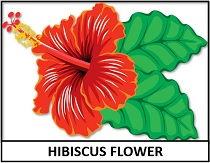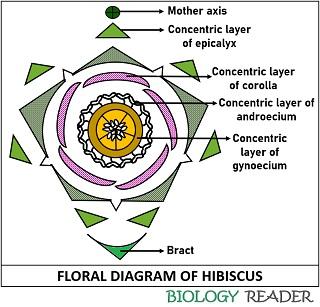The floral diagram is a diagrammatical description of the properties like arrangement, position, structure, aestivation, connotation and adnation of the floral components. It was first introduced in the 19th century by the scientist named August Wilhelm Eichler. A floral diagram illustrates the different floral components by the characteristic symbols. It has a circular outline.
There are four floral whorls, namely calyx, corolla, androecium and gynoecium, which can be depicted in discrete concentric circles of the pictorial floral diagram. In this context, we will discuss the preparation of floral diagram with example and the uses or objectives of the pictorial floral diagram.
Content: Floral Diagram
Definition of Floral Diagram
Floral diagram portrays the cross-sectional view of the flower bud, and provides the easiest way to study the number, position, arrangement of all the floral whorls, and other floral characteristics in a single view. It also helps us to determine the different floral planes through the relative position of the perianth, androecial and gynoecial components respective to the floral axis.
Uses
- It reveals that the flowers of the different family have different floral characteristics, for which a representation of the floral diagram differs in each family. Thus, it is useful in understanding the different groups of flower and also in visualizing the floral symmetry or morphology.
- We can also look upon the kind of aestivation the flowers have. Aestivation is a property of a flower that shows the organization of perianth, which can be valvate, imbricate, twisted, quincuncial and vexillary.
- A floral diagram also reveals the nature of the flower, like whether it is actinomorphic or zygomorphic, complete or incomplete, bracteate or ebracteate, monoecious or dioecious etc.
- The cohesion and adhesion is a feature of stamens, in which a former represents the fusion of stamens themselves and a latter represents the fusion with perianth. Cohesion can be three kinds, namely syngenesious, synandrous and adelphous, while adhesion is generally epipetalous and epiphyllous.
- Through a floral diagram, one can also visualize the anther lobes and the kind of attachment between anther and filament.
- Properties like the position of an ovary, kind of placentation, the number of locules and ovules can also be represented through a floral diagram.
How to Draw
The preparation of the floral diagram is different for the flowers of a different family. But, here we will study the general idea of preparing a floral diagram through step-wise explanation:
Mother axis
First, draw a tiny circle for the actinomorphic and zygomorphic flowers, which will indicate the floral organization relative to their mother or floral axis. For both actinomorphic and zygomorphic flowers, the symbol of mother axis is different. A circle is not drawn in the case of terminal buds.
Bract
Then to represent the bracteate nature of flowers, draw a section of bract by leaving a small space in the middle. In the case of ebracteate flowers, this step is being avoided.
Calyx or Sepals
Then observe the given flower to know the number of sepals and their organization with respect to the floral axis.
Corolla or Petals
Again follow the same protocol to represent the organization of petals relative to the main stem or receptacle. Although, It is drawn interior to the concentric layer showing the arrangement of sepals.
In the case of zygomorphic flowers, both sepals and petals are drawn of unequal sizes due to the irregular symmetry of the flower relative to the floral axis. Oppositely, the actinomorphic flowers have regular symmetry by which both the sepals and petals are drawn of equal size.
The aestivation or organization of sepals and petals may differ in flowers of a particular family. Spurred sepals or petals is represented by drawing a loop at the back of that specific part. When a part of sepals or petals is fused, then simply connect their edges by drawing a line.
Androecium or Stamen
Then to represent the third whorl, i.e. stamens, we need to study their number, arrangement, cohesion and adnation, position in relation to floral whorls, and introrse or extrorse property etc. It is drawn inside the concentric circle representing the petals. In the floral diagram, it illustrates the T.S. of an anther.
Gynoecium or Carpel
Like stamens, the representation of gynoecium also requires a thorough study of its number, organization and the type of placentation in a particular flower. In the floral diagram, it depicts a cross-section of the ovary. The number of ovules attached to locules is also drawn in the floral diagram to show the kind of placentation.
Example
We have discussed the preparation of the floral diagram, but to understand this more in detail, we need to look upon the example explained below:
Floral Diagram of Hibiscus
To draw the floral diagram of Hibiscus rosa sinensis, we must study all the characteristics of the flower, like aestivation, the number of whorls, inflorescence, the position of the ovary, type of placentation etc.

Stem: Its stem appears cylindrical, straight, aerial and bifurcated.
Leaf: Its shape ranges between oval to lance-like and appears with serrated margins and palmate venation. The leaves of Hibiscus flower originates from both the nodes and branches, i.e. the leaf are Cauline and Ramal type. Besides, leaves are stipulate (possesses stipules) and petiolate (bears petiole).
Inflorescence: Hibiscus flowers of Malvaceae family have inflorescence of solitary-axillary pattern, i.e. a single flower originates from the axis of leaves and branches of the plant.
Flower: The flowers are bracteate, i.e. possess leafy structures at the base of the pedicle, pedicellate (bears pedicle), complete (contains all four whorls), actinomorphic (have regular symmetry) and bisexual (comprises both stamen and carpel).
Epicalyx: It constitutes a secondary whorl around the concentric layer of the calyx, and comprises 5-7 group of bracts.
Calyx: It is the first floral whorl, which is 5 in number, green-coloured, gamosepalous (united or partly united sepals). The sepals of hibiscus flowers are attached to the edges of petals (valvate aestivation) and inferior in position, i.e. above the ovary.
Corolla: It is the second floral whorl, which contains five petals with red-pink coloured, twisted and inferior in position.
Androecium: The stamens of Hibiscus flower are indefinite, inferior, introrse. The filament of stamen is fused to form a hollow tube (monoadelphous), and its attachment with the anther is basifixed (filament affixed to the anther’s base). Anthers are monothecus (single-lobed).
Gynoecium: The ovary of Hibiscus flowers is syncarpous or united and hypogynous or superior in position. The number of locules in the ovary is five, i.e. pentalocular and shows axile placentation.
Floral Formula: K5 C5 A∞ G(5)
Significance
Therefore, we can conclude that the floral diagram is the best way to represent all the morphological features of a flowering plant in a single diagrammatic view. Previously, the features like growth behaviour, vegetative properties and all the floral characteristics were used to elucidate the flower.
Now, the floral diagram outlines the floral characteristics of different flowers. Thus, the introduction of floral diagrams helped us to study the flower nature, symmetry, sexuality, inflorescence, placentation, aestivation, and degree of connotation or adnation.

